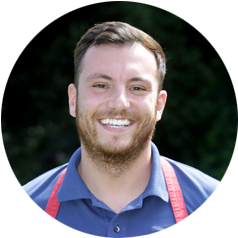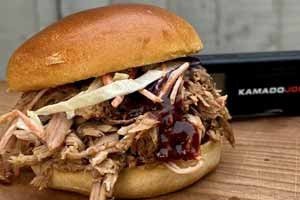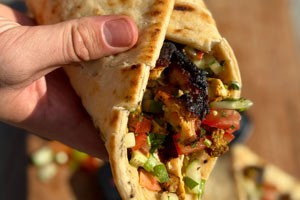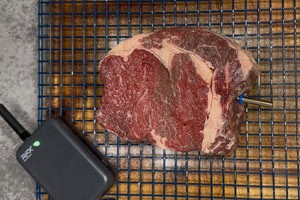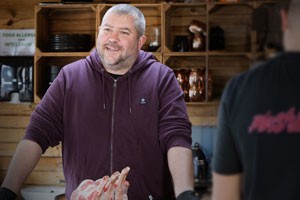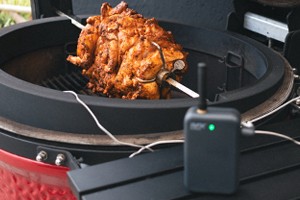Easy, tender BBQ pulled pork, loaded into buns with coleslaw and BBQ sauce.
How to Cook Smoky BBQ Brisket with Mike Tomkins
MasterChef finalist 2021 Mike Tomkins takes us through his ultimate guide to cooking melt-in-the-mouth BBQ brisket.
When I think of BBQ, I daydream about low and slow cooking. Perfectly smoky BBQ brisket that's been cooking all day and is incredibly juicy!
These low and slow cooks can be daunting, though. When I started I was getting inconsistent results. The meat was coming out dry and overcooked, wasting time, effort and money. What was I doing wrong? I was cooking to time instead of temperature.
Once I realised this fundamental mistake, my whole BBQ world changed. Cooking to temperature is key, completely taking the guesswork out of low and slow cooking. It means you can be really precise when you're tackling those longer cooks.
You will need
- Beef brisket
- American mustard
- Salt & pepper
- Kitchen foil
- Lumpwood charcoal
- Smoking wood chunks ( I used Slim Ricks American Bourbon Barrel Chunks)
Brisket Temperature tips
I think the best intermediate low and slow cook has to be brisket. It's a classic American BBQ dish; tender and juicy with an iconic pink smoke ring.
With slow-cooked recipes like BBQ brisket, it's really important to have a great meat thermometer to monitor your cook. I'd strongly recommend the Thermapen Smoke. With two probes and a wireless receiver, it's a brilliant option. The two probes mean you can monitor your meat and pit temperatures (don't trust the built-in BBQ thermometer) without constantly opening the lid and probing the meat.
Remember, if you're looking, you aren't cooking. When you open the lid, heat escapes and it takes a while for your pit to return to temperature. A changing temperature in your grill can also really impact your cook. When I'm unsure of what temperature I need for my pit, I heat my grill to 120 °C. I find this is a safe cooking zone for most low and slow meats.
Directions
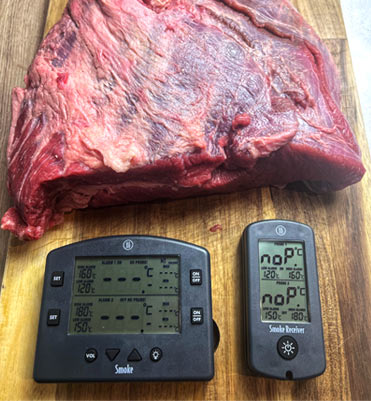
Step 1 - Prepare your brisket
- Carefully trim excess fat and gristle from the brisket as this can result in uneven cooking. When I trim brisket, I aim to have the whole brisket as even as possible to set myself up for the best possible cook.
- Cover the brisket in American mustard; this doesn't add any flavour to the final cook but allows your seasoning to bind to the meat better. Coat your brisket evenly with 50/50 salt and pepper and pop it into the fridge until you're ready to cook.
Step 2 - Prepare your pit
- Fill the pit with lots of lumpwood charcoal. You're looking for a long, slow cook here, so lots of charcoal is needed. Add some smoking wood chunks of your choice for more flavour.
- Set up your Smoke thermometer's pit probe with a high alarm of 130 °C and a low alarm of 110 °C. You want to maintain this range for the entire cook. Once the pit temperature is within range I'll hold it there for around an hour before putting the brisket into the BBQ. This is to make sure I'm in control of the cook.
- The Smoke thermometer is great here because you can monitor the temperature with the lid closed and with the remote receiver so you're not constantly standing over your BBQ. If the temperature goes out of range, you can make adjustments to get it back on track.
Step 3 - Cook to 55 °C
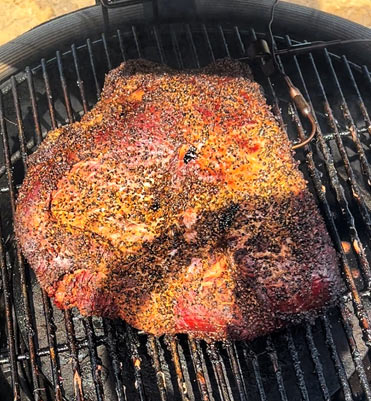
- You're now ready to get cooking. Set up the Smoke thermometer's food probe with a high alarm of 55 °C. Place the brisket on the BBQ and shut the lid, trapping in all that smokiness.
- When you transfer your brisket to the BBQ, aim to keep the lid open for as little time as possible to avoid your temperature dropping out of range too much. Don't worry if the alarm sounds on your receiver to say it has fallen below temperature, the temperature will rise again.
- At this stage, we're cooking the brisket to 55 °C. This is when it will have developed a nice dark bark. The question I get asked a lot here is "How long will it take?", but it's impossible to answer this question. Every brisket cooks differently, which is why it's so important to cook to temperature and not time.
Step 4 - Cook to 75 °C
- The next key temperature is 75 °C. At this temperature, the brisket will need to be wrapped.
- Once your brisket reaches 55 °C, spritz it with cider vinegar and change the high alarm on the Smoke's food probe to 75 °C. Spritz the brisket with cider vinegar every 30 minutes until it reaches temperature, again trying not to have the lid open too long.
- Once the brisket reaches 75 °C, it will have developed the iconic dark bark you're looking for. Again, I couldn't tell you how long this will take - it's all about temperature!
- Now it's time to wrap the brisket. I use foil which is sometimes frowned upon in the Texas BBQ world who insist it has to be butcher paper. However, foil is a great option for any low and slow cook as it retains a lot of moisture in the meat.
- Remove the temperature probe and wrap the brisket really tightly in foil. Reinsert the probe through the foil and into the centre of the brisket. Keep the lid closed while you do this to maintain the pit temperature.
Step 5 - Cook to 96 °C
- We're on the home stretch now! Adjust the high temperature alarm to 96 °C on your Smoke, close the lid and walk away. This is the final cook; when your brisket reaches 96 °C you will have perfectly tender meat.
- Once it reaches temperature, I use my Thermapen digital thermometer to test the resistance of the brisket. The probe should slide through the meat like butter.
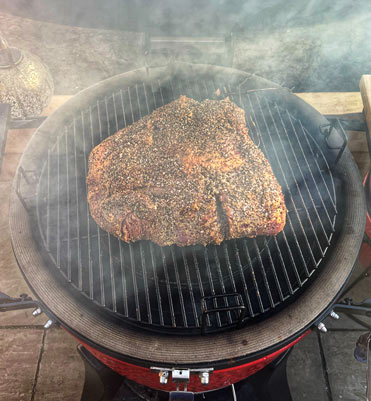
Step 6 - Rest to 63 °C
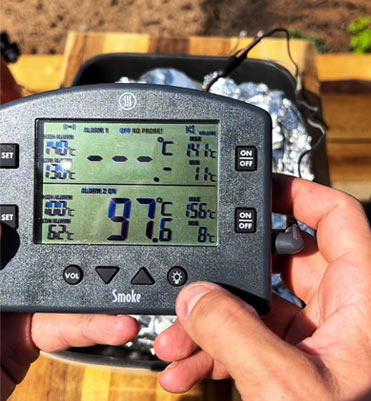
- One of the most important parts of a low and slow cook is resting. A low and slow cook has gone through a significant and long change, so it's time to treat it to a rest.
- Set the low alarm on the Smoke thermometer's food probe to 63 °C. This is the golden temperature for slicing into the brisket. Leave it wrapped in foil as it rests; this will ensure the meat is super moist and you can get that juicy Instagram shot.
- Whilst the brisket is resting, you can take your receiver with you and get prepping on your sides. Once it reaches 63 °C, it's time to slice against the grain; cutting against the fibres of your brisket ensures the most tender bite of brisket, every time!
"Thermapen is one of those kitchen tools I can't live without - it's something I use every single day from making sauces, to bbq cooking, to private dining and events, it comes with me everywhere! A Thermapen will improve you as a chef and a cook by taking the guess work out of complex cooking."





